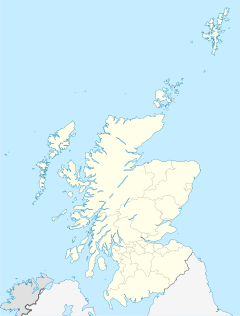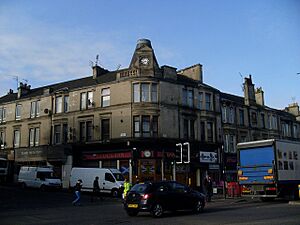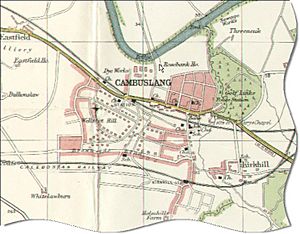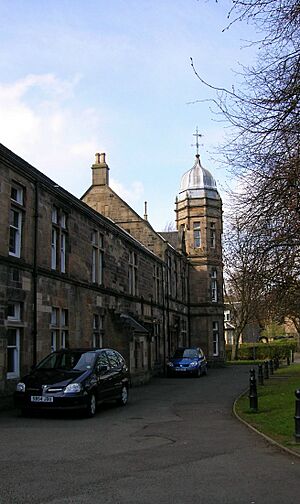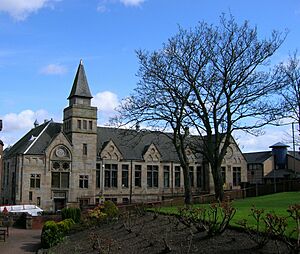Cambuslang facts for kids
Quick facts for kids Cambuslang
|
|
|---|---|
| Town | |
 Cambuslang main street, 2013 |
|
| Population | 30,790 (2020) |
| OS grid reference | NS642605 |
| Lieutenancy area | |
| Country | Scotland |
| Sovereign state | United Kingdom |
| Post town | GLASGOW |
| Postcode district | G72 |
| Dialling code | 0141 |
| Ambulance | Scottish |
| EU Parliament | Scotland |
| UK Parliament | |
| Scottish Parliament | |
Cambuslang (pronounced 'kæmbəslæŋ) is a town in Scotland. It's located on the southeastern edge of Greater Glasgow. About 30,000 people live here. Even though it's a large town, some people call it Scotland's biggest village because it has never had a town hall!
Cambuslang is part of the South Lanarkshire area. It's right next to the town of Rutherglen to the west. Historically, it included smaller areas like Newton and Halfway.
The town sits just south of the River Clyde. It's about 6 miles (10 km) southeast of Glasgow city centre. Cambuslang has a long history of important industries. People have been coal mining here since at least 1490. It was also known for iron and steel making. Famous companies like The Hoover Company used to have factories here. Today, some manufacturing continues, but most jobs are in distribution or service industries. The main office for the Scottish Fire and Rescue Service is also in Cambuslang.
Contents
A Look Back: Cambuslang's History
Cambuslang's history is shaped by its location. The land was good for farming, producing food, then wool, and later linen. It also had valuable resources underground, like limestone, coal, and iron. These resources helped the town become wealthy over time. Important families, like the Duke of Hamilton, looked after these lands.

Because Cambuslang was quite wealthy, it played a part in the country's politics. Important religious leaders, like Bishop John Cameron and Cardinal Beaton, were connected to Cambuslang.
Over the centuries, many people moved to Cambuslang. They came from all over Scotland, Ireland, and other European countries. They were attracted by the growing industries. Being close to Glasgow helped Cambuslang grow. In the 18th century, a turnpike road made travel easier. In the 19th century, a railway connected the towns even more. Today, Cambuslang still benefits from being near Glasgow and major roads like the M74 motorway.
In sports, Cambuslang F.C. was one of the first teams in the Scottish Football League. They were runners-up in the 1887–88 Scottish Cup. Later, a new team called Cambuslang Rangers F.C. was formed and is still playing today. They were very successful in the 1970s.
How Cambuslang is Governed
Cambuslang is part of different areas for elections and local services.
Representing Cambuslang in the UK Parliament
For elections to the British House of Commons in London, Cambuslang is in the Rutherglen Constituency.
The current Member of Parliament (MP) for this area is Michael Shanks. He is from the Scottish Labour Party.
Representing Cambuslang in the Scottish Parliament
For the Scottish Parliament in Edinburgh, Cambuslang is in the Rutherglen area.
Clare Haughey from the Scottish National Party (SNP) is the Member of the Scottish Parliament (MSP) for this area. She was first elected in 2016 and re-elected in 2021.
Local Council: South Lanarkshire
For local services, Cambuslang is managed by South Lanarkshire Council. The town centre is in the Cambuslang West area. Including the eastern parts of the town, Cambuslang has about 30,000 people. Many services are shared with nearby Rutherglen, serving a total of about 60,000 residents.
Cambuslang's Location and Landscape
Cambuslang is located on a large bend of the River Clyde, southeast of Glasgow. It's easy to get to by car from the M74. The A724 road connects it to Glasgow city centre and Hamilton. You can also reach it from East Kilbride using the A725 and A749 roads.
The town has its own train station, Cambuslang. This station is on the Argyle Line, which runs between central Glasgow and Lanark.
The area is mostly low-lying. The highest points are Dechmont Hill (602 feet or 183 metres) and Turnlaw Hill (553 feet or 168 metres). There are even remains of an Iron Age fort on Dechmont Hill!
Important Places in Cambuslang
Cambuslang has many interesting buildings. These include churches, public buildings, schools, and older homes. You can find 19th-century mansions, villas, and modern apartments.
Parks and Sites
Cambuslang Park is a large green space covering 27 acres (11 hectares). It has open grassy areas and the Borgie Glen, which is a steep, tree-lined valley with many paths. The park also features a pond, sports fields, a war memorial, and a natural amphitheatre called the Bandstand. This is near where a famous religious event called the Cambuslang Wark happened in the 18th century.
Schools and Learning
Cambuslang has many schools for children of different ages. While there are no longer any colleges directly in the town, there's a history of further education here.
Primary Schools
Here are some of the primary schools in Cambuslang:
- Cairns Primary School
- Hallside Primary School
- James Aiton Primary School
- Newton Farm Primary School
- Park View Primary School
- St Bride's Primary School
- St Cadoc's Primary School
- St Charles' Primary School
- West Coats Primary School
Secondary Schools
The main secondary schools are:
- Cathkin High School
- Trinity High School
- Rutherglen High School (which supports students with additional needs)
Some students in Cambuslang might also go to Stonelaw High School in nearby Rutherglen.
Colleges and Training
Cambuslang used to have a college called Cambuslang College of the Building Trades. It grew to teach many different subjects and became South Lanarkshire College. In 2008, the Cambuslang campus closed, and all its facilities moved to a new campus in East Kilbride.
The national training centre for firefighters in Scotland is located in Cambuslang. This is where firefighters learn and practice their skills.
Early Schools
Cambuslang has had schools for a very long time, even before the Scottish Reformation. The first public school building from 1882 is now the Greenlees Care Home. An even older school building from 1848, called the Cambuslang Subscription School, is now a Gospel Hall. This school provided basic education to children of miners and weavers.
Getting Around Cambuslang
Cambuslang has good transport links. There are three train stations: Cambuslang, Kirkhill, and Newton. These stations connect the town to Glasgow and other areas.
Many bus routes also pass through Cambuslang, mostly operated by First Bus Glasgow. There are also local taxi companies.
The National Cycle Route 75 goes through Cambuslang. In 2016, special cycle lanes were added to the Main Street, making it easier for people to cycle.
Famous People from Cambuslang
Many interesting people have connections to Cambuslang.
St Cadoc
St Cadoc (around 497 – 580 AD) is said to have founded a monastery where the Old Parish Church now stands. He is the patron saint of Cambuslang, and a modern primary school is named after him. People used to ask for his help if they were deaf or had cramp. He was a Celtic saint who traveled widely, even to Rome and Jerusalem.
David Dale
David Dale (1739–1806) was a Scottish businessman and a kind person who helped others. He was very successful in the cotton industry and helped start the New Lanark Mills. Dale owned a large house called Rosebank in Cambuslang, which he used as a summer home.
James Meek
Rev Dr James Meek (1739–1810) was the Minister of Cambuslang for many years. He was also a Dean at Glasgow University. He wrote an important historical report about the "Cambuslang Wark" and kept a detailed journal about the weather for 29 years, which is still used today! He is buried in the Old Parish Church graveyard.
Other Notable People
- David Beaton (c. 1494–1546) was a religious leader connected to Cambuslang.
- Sir George Burns (1795–1890) was a shipping leader who helped start the Cunard Line. He lived at Rosebank House.
- Robert Crawford (1959–) is a Scottish poet and professor who wrote a poem about Cambuslang.
- William Hamilton of Gilbertfield (1665–1751) was a poet who wrote about William Wallace. The famous poet Robert Burns even praised his work!
- Scott Harrison (1977–) was a World Boxing Organisation featherweight boxing champion.
- John Claudius Loudon (1783–1843) was a famous gardener and designer. He invented a special iron-bar sash that made huge greenhouses possible, like those at Kew Gardens.
- Sir Thomas Lipton (1850–1931), famous for his tea company, lived in Cambuslang.
- Mick McGahey (1925–1999) was an important leader for miners.
- Midge Ure (1953–) is a pop singer and campaigner who helped organize Band Aid and Live 8 to fight hunger.
- Robert Wilson (1907–1964) was a famous opera and concert singer.
Images for kids
See also
 In Spanish: Cambuslang para niños
In Spanish: Cambuslang para niños


